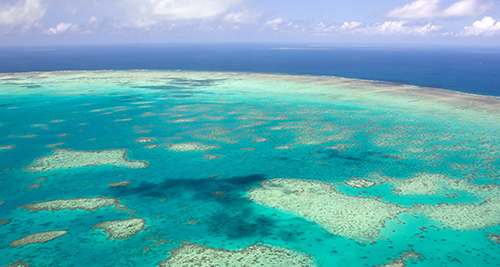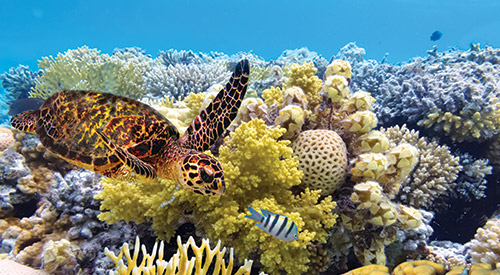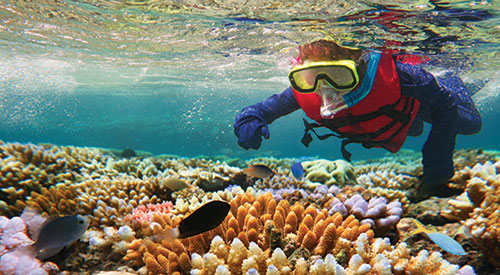To understand the scope and magnitude of the Great Barrier Reef along the eastern shores of Queensland, Australia, one needs to imagine a delicate ecosystem made up of billions of microorganisms that stretches more than 1,400 miles (2,253 kilometers) – approximately the entire length of the western coast of the United States, from Seattle to San Diego.
The Great Barrier Reef is considered to be one of the seven wonders of the natural world, alongside the likes of Mount Everest and the Grand Canyon, and it is the largest coral reef system on earth. Fabricated of billions of microscopic coral polyps of over 400 different types of coral, the Great Barrier Reef is comprised of 3,000 individual reefs and features nearly 1,000 islands.
>> Download full copy of Mission: Water Magazine
>> Download The Great Barrier Reef from Mission: Water Magazine
As the largest living organism in the world, the Reef is home to over 1,500 species of tropical fish, more than 200 types of birds, nearly two dozen types of reptiles, and it’s the breeding grounds for humpback whales migrating from the Antarctic. It’s also home to numerous endangered species, including the Sea Cow (Dugong) and the large Green Sea Turtle.

In 2016 The Sydney Morning Herald reported that coral bleaching was more widespread than previously thought, seriously affecting the northern parts of the reef as a result of warming ocean temperatures.
The Devil Is In The Details
The Great Barrier Reef is a colossal natural phenomenon and as a result, is a global tourist destination – and has been for decades. But as beautiful as the Reef is, and as vibrant as it may appear to the untrained eye, scientists are becoming increasingly concerned that the Reef itself is becoming permanently endangered.
Cutting-edge water quality monitoring instrumentation provides real-time data and detailed information about the earth’s oceans, measuring temperature, turbidity, pH, DO (dissolved oxygen), and other parameters that are harbingers of the health of an ocean ecosystem. With this valuable information, oceanographers around the world can determine trends and assess the possible impact, with an accurate picture of the wellbeing of our oceans and the ecosystems that subsist within them. Such is the case with the Great Barrier Reef, and the numbers don’t look good.
The Great Barrier Reef – It Isn’t Pretty
Visitors to the Great Barrier Reef continue to be amazed by the sheer beauty of the Reef and the abundance of colors and the abundance and variety of marine life. But the damage caused to the Reef over the past 30-40 years has left the Reef in trouble, with coral bleaching taking its toll on much of the Reef surface area. And it isn’t pretty.

The Great Barrier Reef before bleaching and after bleaching (right).
When ocean waters get too warm, corals will push out the algae (which give the corals their vibrant colors) living in their tissue, causing the coral to turn completely white (ergo bleaching). Coral can survive a bleaching event, but it does put stress on the living organism, and repeated stress can eventually cause the coral to die.
Increasing Temperatures and Decreasing pH
Scientific instruments monitoring our waters are telling us that oceans are in a warming trend and pH is falling, and this rightfully has scientists and environmentalists concerned. An El Niño event in 2015 in Australia resulted in significant bleaching of the Great Barrier Reef in 2016, impacting the northern third of the Reef. Subsequent bleaching again in early 2017 – this time in the middle third section of the Reef and without the occurrence of an El Niño – makes it that much more alarming.
Reefs and sea life have also been impacted by ocean acidification, caused by an increase in carbon dioxide absorbed by ocean waters. As a result, scientists are seeing trends of ever-so-slight decreases in ocean pH. Much like the miniscule increases in ocean water temperature and the subsequent coral bleaching events, these minimal decreases in pH can have a long-term impact on the stony skeletons that support corals as well as the shells of clams, snails, and sea urchins.
Like any ecosystem, the damage or destruction of a component of the system has an offsetting impact on the rest. Continued stress on the Great Barrier Reef will impact regional fisheries, as they provide shelter and habitats for numerous marine organisms and are a key source of nitrogen and critical nutrients for marine food chains.

The Great Barrier Reef supports a diversity of life, including vulnerable or endangered species.
Did You Know?
Observations made by the scientific community over the past 40 years are difficult to ignore:
- The temperature of the world’s oceans are in a warming trend; increases of just a degree or two can have a disastrous impact on plant and animal life.1
- The Great Barrier Reef coral cover has declined by approximately 50% since 1985.2
- The past two to three decades have seen significant bleaching events in much of the world’s coral reefs, not just in the Great Barrier Reef.2
1 SEPA (epa.gov)
2 Australian Institute of Marine Science (aims.gov.au)
It’s Not All Doom and Gloom
The Great Barrier Reef provides billions of dollars of economic benefits to Australia, both directly supporting the fishing industry and indirectly supporting the tourism industry. Ultimate devastation to the Reef would result in unimaginable devastation to the Australian economy.
Creating awareness of the damage to the Great Barrier Reef can also be a challenge, especially with organizations that rely on the Reef for economic and cultural benefit, as they may be reluctant to promote the damage. The thought being that if potential visitors are made aware that Reef damage/destruction is prevalent, then there’s a chance that less people will visit the natural phenomenon, thinking it’s “less than what it used to be” and not worth the trek to the land “Down Under.”
>> Download The Great Barrier Reef from Mission: Water Magazine
Fortunately, in March of 2015, to affirm and continue the previous 40 years of conservation efforts, the Australian and Queensland governments developed and released the Reef 2050 Plan. A first-ever government initiative that outlines a 35 year plan to protect the Reef, the Plan was devised with the help of an advisory committee and independent expert panels of scientists and environmentalists, and it ensures the sustainability of the Reef for tomorrow and for future generations.
Australia’s Department of the Environment and Energy describes the Reef 2050 Plan as, “Setting clear actions, targets, objectives and outcomes to drive and guide the short, medium and long-term management of the Reef. It firmly responds to the pressures facing the Reef and will address cumulative impacts and increase the Reef’s resilience to longer term threats such as climate change.

Government initiatives... ensures the sustainability of the Reef for tomorrow and for future generations.
At the core of the [initiative] is an outcomes framework that will drive progress towards an overarching vision, as well as an investment strategy to fund the countless action items mapped out. Since the inception of the [Reef 2050] Plan in March of 2015, 89% of the actions for the first five years have either been started, completed, or at least on track and targeted for completion.”
Reality Versus Rhetoric
For anyone who’s looking, there is a tremendous amount of data and information and articles written on climate change, ocean acidification, and the Great Barrier Reef in particular. From the journal Nature to the NY Times to Brietbart.com, to Outside magazine writing an “obituary” of the Great Barrier Reef in their October 11, 2016 issue [Obituary: Great Barrier Reef (25 Million BC-2016)], countless writers have written. But at the end of the day, if we want to continue to enjoy the beauty that is Mother Nature that is so abundant everywhere we turn – and especially as we plunge into the depths of our oceans – it is prudent for us to continue to obtain and assess the data that our technological advances can offer us.
Otherwise, we run the risk of turning a blind eye to the damage and the possible permanent destruction of the natural wonders of the world. And the challenges we thought were a millennia away will escalate exponentially and come to roost much sooner than we ever expected.
If you believe half the rhetoric that’s out there, it already has.
